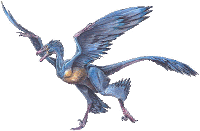The work was done by researchers from the Institut Català de Paleontologia (ICP) and Universitat Autònoma de Barcelona (UAB); and has just been published in the journal Nature.
The researchers analyzed the bones of around a hundred different ruminants, representing the full ecological diversity of that group, and studying the lines of arrested growth (LAG) in the bones. They found that the presence of these lines of arrested growth is not an indicator of an ectothermic (cold-blooded) physiology, as was previously thought, since warm-blooded mammals all have them. This completely refutes the main argument of the hypothesis that dinosaurs may have been cold-blooded reptiles.
The work was carried out by Meike Köhler, ICREA researcher and ICP palaeontologist; Ronny Aanes, researcher from the Norwegian Polar Institute; Nekane Marín, PhD student at the UAB and Xavier Jordana, lecturer of postgraduate studies at same university.
“The study we have carried out is very powerful, both in terms of the amount of material and the diversity of species with which we worked, but we did not design it to find a response to the thermophysiology of dinosaurs. We sought to better understand the physiology of extant mammals and how the environment affects them — how their growth changes as a result of external temperatures, rain and the availability of food and water,” explains Meike Köhler.
But what the researchers observed in the bones of the ruminants they were studying completely dismantled the main argument for a cold-blooded physiology in dinosaurs. “Many hypotheses set out from the premise that large mammals — endothermic par excellence — do not have LAGs in their hard tissues since they do not need to arrest their growth responding to external temperature conditions. In fact, since LAGs have been observed in almost all species of dinosaur, many scientists considered that they were cold-blooded reptiles.”
This new research is “the first systematic study, based on an extensive sample of mammals representative of a large variety of ecosystems, which shows that LAGs do not indicate an ectothermic physiology but give us information about how the physiology (metabolism) of an animal changes according to seasonal endocrinal changes, both in cold- and warm-blooded animals. These changes represent a common heritage in all vertebrates and are a kind of internal clock that regulates the animals’ needs according to the seasonal availability of resources. Despite the fact that these physiological changes have a strong genetic component, they are also functional and their intensity depends on the ecological conditions in which the animals live. The main ecological factors are more rain and limited supply of food and water, rather than external temperature. This discovery opens up a major line of research into the conservation of biodiversity on our planet today.”
“It may seem surprising that until now there has not been a similar systematic study to prove or disprove whether it is only ectotherms that leave these marks in their bones during growth. In fact, there are so many things we do not know that science does not always advance in a linear way. The ideas somehow had long been wandering among the scientific community, but the work we have published organizes them and bases them on data,” says researcher Meike Köhler.
Some previous research had already questioned the very weakly-supported cold-blooded hypothesis, and there was already the idea among the international scientific community that LAGs didn’t necessarily indicate ectothermy. Examples of mammals that appeared to have LAGs in their bones had already emerged. This study very clearly finishes the debate though.
Most previous evidence shows dinosaurs as often having more in common with modern mammals than modern species of reptiles; growth-rate, posture/movement, feathers/insulation on smaller species, polar habitation/little sunlight during winter, high metabolic rate/requirements, erect limbs, adaptions to running, body temperature, and bone structures.
Though of course dinosaurs wouldn’t necessarily have metabolisms that closely resemble that of any living species, different species of dinosaurs could have displayed a widely varied mix of different ‘warm-blooded’ and ‘cold-blooded’ features.
For more information related to dinosaurs, visit rareresource.com.






























